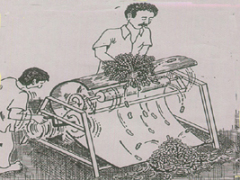Ground Nut Pod Separator/ Wool Ginning Machine
Marut Roa Sarode and his two friends, Marutrao Kadam, a cobbler, and Gangaram Sakve, a carpenter had keen interest in new ideas. His friends used to help him after finishing their own work, as they did not have any family obligations. They would all have discussions till late in the night.
Marutrao got his first patent for a groundnut pod separator sealed in December 1990 (patent no 175864), well after he had crossed the age of seventy and sixty years after his first invention.
Groundnut Pod Separator:
Groundnut is harvested by uprooting the whole plant by grasping its foliage. The pods are then separated by picking them individually by hand, or in bulk by twisting the roots with one hand while holding the plant firmly in the other, or by threshing: striking the roots on a horizontal stick or steel blade. All these methods are tedious. Marutrao Yashwant Sarode designed and fabricated a unique pod separator that used rotating blades to snip off the pods. He used a bullock-drawn blade harrow to loosen the plants first so that they were then easy to uproot.
He had two friends, Marutrao Kadam, a cobbler, and Gangaram Sakve, a carpenter. They used to help him after finishing their own work, as they did not have any family obligations. They would all have discussions till late in the night.
Marutrao got his first patent for a groundnut pod separator sealed in December 1990 (patent no 175864), well after he had crossed the age of seventy and sixty years after his first invention.
Wool Ginning Machine:
He began to design a wool-ginning machine based on the cotton gin he had seen in Indore. He finalized the design in 1942 and over the next six years, set about getting the components for it from the district headquarters and from Mumbai's Lokhand bazaar. He acquired pedestal bush bearings and shafting. He fixed 1200 nails on a wooden strip to form a comb and mounted it on the outer flat surface of a belt pulley. A stationary comb of nails was fixed in a curved housing below the pulley in such a way that nails on the pulley passed between the teeth of the comb. The pulley had a sprocket attached, and a chain and crank handle could be manually turned to achieve speeds between 60 and 100 rpm. One person fed in the raw wool while another turned the handle. The gin worked continuously and efficiently for 12 years; it still sits in the village.








